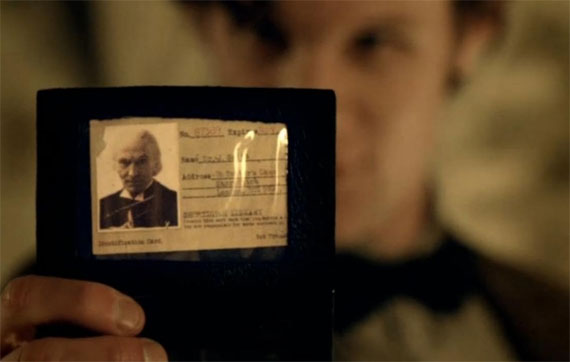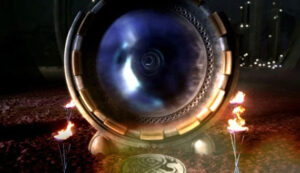Who is the Doctor?
Guest contributor Nick Ferrazza explores what we actually know about the origins of our favourite Time Lord.

I think it’s fair to say that one of the underlying themes of Doctor Who from its very beginning is the fact that we know very little about that strange man who calls himself ‘the Doctor’. Sure, we know he’s a Time Lord from the planet Gallifrey. We know he stole an old Type 40 TARDIS that he now travels through time and space in. We know he enjoys sharing his travels with ordinary people, has a love for the planet Earth, and no matter what he will ultimately do what he believes is good, but when you really think about it we really know nothing about him. We don’t even know his name. The purpose of this article is to gather what little information there is about the Doctors past and see if we can piece together a rough image of what he’s all about.
Birth and Family
 The television stories alone give us very little information about the Doctor’s birth. We know of course that he was born on Gallifrey. According to ‘The Creature from the Pit’, he was born under the sign of the crossed computers, and ‘A Good Man Goes to War’ has shown us his first stars in the form of his cot. To get any further though, we will have to stretch outside the limits of the TV series and see what the book, audios and comics have to say about his past. It is worth noting that, as with all mediums of Doctor Who outside of the TV show, the canonicity of the stories is questionable, with some sources conflicting with others. All of this should be taken with a pinch of salt.
The television stories alone give us very little information about the Doctor’s birth. We know of course that he was born on Gallifrey. According to ‘The Creature from the Pit’, he was born under the sign of the crossed computers, and ‘A Good Man Goes to War’ has shown us his first stars in the form of his cot. To get any further though, we will have to stretch outside the limits of the TV series and see what the book, audios and comics have to say about his past. It is worth noting that, as with all mediums of Doctor Who outside of the TV show, the canonicity of the stories is questionable, with some sources conflicting with others. All of this should be taken with a pinch of salt.
An unused plot thread of the TV movie presented the Doctor’s father as a Time Lord known as Ulysses. This idea would later extend into the Eighth Doctor Adventures novel range, particularly in the final story ‘The Gallifrey Chronicles’. In these stories, Ulysses is presented as a similar man to that which his son would grow up to be. He was a renegade, with a love for Earth and even had a human companion in the form of Penelope Gate.
It is this human Penelope Gate, a young woman from Victorian London and inventor of a time machine of her own, who would, according to ‘The Gallifrey Chronicles’, go on to give birth to Ulysses son, the baby who would grow up to be the Doctor. This of course supports the Doctor’s claims that he’s half-human, but as is the nature of Doctor Who, this may not be the true account of his origins, as the 10th Doctor makes clear in ‘Journey’s End’ that a half-human half-Time Lord is impossible. Whether or not this is the true history of the Doctor’s parents cannot be determined for sure, but it is certainly a strong contender.
There is also the issue as to whether or not the Doctor was actually ‘born’ in the traditional sense. The Virgin New Adventures, in particular ‘Cat’s Cradle: Time’s Crucible’ and ‘Lunburrow’, suggests that Time Lords are barren and that their young are created fully grown in a device known as a loom. These stories suggest that the Doctor was loomed into the House of Lungburrow, and was perhaps even a reincarnation of the mysterious Other, who alongside Rassilon and Omega founded Time Lord society. This theory of the Doctor being born a fully grown man voids the need for a cot in ‘A Good Man Goes to War’, and so may not be entirely canon.
One thing that is for certain however is that the Doctor had a brother known as Irving Braxiatel. Although the closest thing we get to an appearance of him on screen is a passing reference to the Braxiatel Collection in ‘City of Death’, he has become an important part of the franchises extended fiction, even going as far to become one of the most prolific characters never to have appeared in the show. Although only a handful of meetings with his younger brother have been depicted, he has become an important part of Big Finish’s spin-off audio ranges, namely ‘Gallifrey’ and ‘Bernice Summerfield’. According to the 1st Doctor novel ‘Empire of Glass’, the Doctor may also have had a sister.
Growing Up and Education
 ‘The Gallifrey Chronicles’ suggest that, when his relationship with a human was threatened to be exposed, Ulysses wiped his wife and sons memories and left them on Earth where they would be free of whatever punishment the Time Lords would see fit to unleash on them, leaving the Doctor to be raised on Earth. However, most other sources tell us that the Doctor remained on Gallifrey for most of his early life.
‘The Gallifrey Chronicles’ suggest that, when his relationship with a human was threatened to be exposed, Ulysses wiped his wife and sons memories and left them on Earth where they would be free of whatever punishment the Time Lords would see fit to unleash on them, leaving the Doctor to be raised on Earth. However, most other sources tell us that the Doctor remained on Gallifrey for most of his early life.
‘The Time Monster’ tells us that the Doctor grew up in a house on the side of Mount Cadon. At the age of eight the Doctor was taken, as all Time Lords were at that age, to gaze into the untempered schism, a crack in the fabric of reality. He responded by running away and never looked back.
He was a close friends with fellow Time Lord Koschei, with whom he formed a brother like bond. The two would spend most of their time playing in Koschei’s father’s fields of red grass. In the academy, Koschei would often hypnotise his fellow classmates, leaving the Doctor to un-hypnotise them.
The 5th Doctor book ‘Divided Loyalties’ perhaps gives us the most in depth look into the Doctor’s time at the academy. It states that in the academy he made many other friends and that together they formed a group of ten known as the Deca. Most members of the group would go on to become renegades like the Doctor. Of particular note was Ushas (the Rani), Mortimus (the Monk), Magnus (the War Chief) and Koschei (I think you can make an educated guess as to the name he eventually took).
He was later expelled from the academy after spending five centuries there when he and fellow Deca members Rallon and Millennia stole a TARDIS and encountered the Celestial Toymaker. This resulted in Rallon being possessed by the Celestial Toymaker and becoming his new body and Millennia being turned into a doll.
Later Life
 The Doctor would eventually go on to father a family of his own. ‘The Eleventh Tiger’ suggests that he had both sons and daughters. His only confirmed descendant however is his granddaughter Susan. Although it has been suggested that Susan wasn’t actually the Doctor’s biological granddaughter (‘Birth of a Renegade’), most sources deny this and fans today generally consider her to be the Doctor’s blood relative.
The Doctor would eventually go on to father a family of his own. ‘The Eleventh Tiger’ suggests that he had both sons and daughters. His only confirmed descendant however is his granddaughter Susan. Although it has been suggested that Susan wasn’t actually the Doctor’s biological granddaughter (‘Birth of a Renegade’), most sources deny this and fans today generally consider her to be the Doctor’s blood relative.
He may also have had two more grandchildren, John and Gillian. According to the TV Comics, these two children were raised on Earth and had no idea of their Time Lord origins until the Doctor came into their lives. It is worth noting that their existence along with the entire run of TV comics is a bit of a continuity nightmare, and several attempts have been made to explain away any relationship the two might have to the Doctor.
Running Away
 Now it’d be one thing for me to tell you the circumstances under which the Doctor left his home planet, but I’m sure most of you would prefer me to answer the big question first: why? Why did the Doctor leave Gallifrey? As you’ve probably guessed, there is no one answer to this question. Each account of the Doctor’s departure gives us a slightly different motivation behind his actions. I will go with, as far as I’m aware, the only one that fits within the continuity of the brief scene from ‘The Name of the Doctor’, Big Finish’s account.
Now it’d be one thing for me to tell you the circumstances under which the Doctor left his home planet, but I’m sure most of you would prefer me to answer the big question first: why? Why did the Doctor leave Gallifrey? As you’ve probably guessed, there is no one answer to this question. Each account of the Doctor’s departure gives us a slightly different motivation behind his actions. I will go with, as far as I’m aware, the only one that fits within the continuity of the brief scene from ‘The Name of the Doctor’, Big Finish’s account.
According to ‘Disassembled’, the sixteenth chapter of the Gallifrey spin-off audio series, the Doctor had in some way broken the Time Lord’s non-intervention policy, something he would go on to do many more times in his life. As a result, his brother Braxiatel, who at the time held the position of Lord Burner, was ordered to ‘burn’ the Doctor. This meant killing the Doctor and erasing any mention of him from the planet’s history, making it look as though he had never existed. Braxiatel however was reluctant to do this and allowed the Doctor time to escape.
‘The Beginning’, an audio story that I would highly recommend if you want to go into any more depth in this area, and ‘The Name of the Doctor’ tell us that the Doctor then took his granddaughter Susan and the Hand of Omega (‘Remembrance of the Daleks’) and, with a bit of help from an impossible girl, stole an old Type 40 TARDIS. The fact that the TARDIS was faulty, and at the time ready for vaporisation, meant that it was deregistered and able to slip past Gallifrey’s transduction barriers with ease.
Unbeknown to either the Doctor or Susan however, their TARDIS wasn’t completely unoccupied when stolen. Upon arriving on the moon (their first destination according to this account) they were confronted by Quadrigger Stoyn, who had been preparing the TARDIS for its vaporisation. Stoyn held an immediate dislike for the Doctor and would grow to become a powerful enemy of the renegade Time Lord in hopes of becoming a nobody who could easily leave the planet undetected.
Eventually, after several adventures with his granddaughter, the Doctor arrived in 1960s London where the TARDIS broke down. Realising that they may be there for a while, the Doctor enrolled his granddaughter in a nearby school. Eventually he got the TARDIS working again and planned to leave. However, not before two of Susan’s teachers, Ian and Barbara, decided to investigate their new pupil’s strange origins. The rest, as they say, his history…
Wrapping Up
So there you have it. A mix-mashed, timey-wimey continuity nightmare that makes up one possibility of the Doctor’s history. As this is only a rough outline of a few possible back stories for our favourite Time Lord, I would urge you to go and look into this in more depth if you are interested. Bear in mind though that with the nature of Doctor Who’s canon, this entire story could be dismissed in mere seconds as soon as something new comes up. For now at least, this in the closest we may get to knowing who the Doctor really is.








